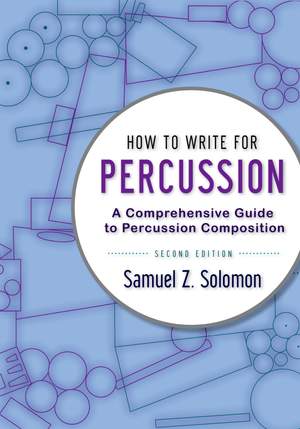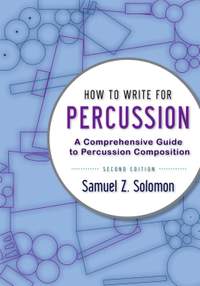How to Write for Percussion: A Comprehensive Guide to Percussion Composition
- Author: Solomon, Samuel Z.
Book
$52.75Special import
Contents
- Table of Contents
- Introduction
- How This Book is Organized
- Instruments Covered
- Working with Percussionists
- Location Specifics
- The Value of Not Reading This Book
- 1. General Framework
- A Dysfunctional Family
- Comparison of Family Relationships
- The Problem of Pitch
- The Pitches of Percussion
- The Validations and Limitations of Novelty
- Three Methods for Indeterminately Pitch Instruments
- The Written/Improv Divide
- Expanding the Color Palette (to Shrink the Setup)
- The Value of Improvised and Non-Notated Music
- Social Composition
- Write for People, Not Sounds
- Write What is Wanted, Not What To Do
- Working with Percussionists
- 2. General Logistics
- Instrument Choice and Management
- Six Stories, Three Sad and Three Happy
- Why Use Fewer Instruments?
- How to Consolidate
- Inexpensive Instruments
- Exotic Instruments
- Electronic Percussion
- Multiple Options for a Specified Instrument
- Instruments Percussionists May Not Play
- Multiple Percussionists
- Section Setup
- Orchestra
- Wind Ensemble
- Broadway Pit
- Drum Corps and Marching Bands
- Specialists
- Non-Percussionists Playing Percussion
- Chairs and Stands
- Issues of Playability
- Excessive Polyphony
- How Fast Percussionists Can Play
- Unidiomatic Writing-Music that Often Requires Memorization
- Dynamics
- Reaching Instruments
- Instruments with Pedals
- Physical Exertion and Shaking
- Working with Headphones or Headset Microphones
- 3. General Notation
- Basics of Percussion Parts and Scores
- Instrument List
- Instrument Key
- Setup Diagram
- Language
- Parts
- Cues
- Percussion in the Conductor's Score
- Dynamics
- Designing a Notational System
- Clefs
- Staves
- Noteheads
- Mixing Determinately and Indeterminately Pitched Instruments
- Key Signatures
- What Goes Where on the Staff
- The Chicken or the Egg?
- Unspecified Instruments (Indeterminate Instrumentation)
- How Much to Notate
- Systems of Notation for Which There is No Standard
- Return to a Normal Method of Playing
- Note Length, Articulation, and Phrasing
- Note Length Chart
- Exact or Inexact Note-Length Indications
- Muting (Muffling, Dampening)
- Dead Stroke
- Damper Pedals
- Rolls
- Notations that are Not Recommended
- Symbol Notation
- Altered Keyboard Notation (Timbre-Staff)
- 4. Beaters
- To Indicate or Not to Indicate?
- Beater Lingo
- Logistical Beater Issues
- Sticks
- Mallets
- Triangle Beaters, Knitting Needles
- Brushes
- Rute
- Chime Hammers
- Superball Mallet
- Beaters as Instruments
- Hands
- Bows
- 5. Keyboard Percussion
- Ranges and Construction
- Writing for Keyboard Percussion
- Stacked Instruments
- Multiple Players
- Extended Techniques
- Miscellaneous
- 6. Drums
- Sticks on Drums
- Mallets on Drums
- Hands on Drums
- Playing on the Rim or Shell
- Beating Spot
- Mutes
- Pitch Bending
- Drum Size
- Two-Headed Drums
- Multiple Drums in Setups
- Idiomatic Writing for Drums
- Timpani
- Tom-toms
- Snare Drum, Field Drum, Tenor Drum
- Concert Bass Drum, Pedal Bass Drum
- Bongos, Congas
- Timbales
- Roto-Toms
- Frame Drums
- Tambourines
- Djembe, Doumbek
- Boobams
- Drumset
- 7. Metal
- Cymbals
- Gongs
- Finger Cymbals
- Cowbells, Almglocken
- Temple Bowls, Mixing Bowls
- Brake Drums, Metal Pipes, Anvils, Bell Plates
- Thundersheet
- Junk Metal, Tin Cans, Pots and Pans
- Ribbon Crasher
- Spring Coil
- Church Bells
- Hand Bells
- Steel Drums
- Tambourines
- Sleighbells
- Metal Wind Chimes, Mark Tree, Bell Tree
- Flexatone
- Extended Techniques
- 8. Wood
- Woodblocks, Templeblocks, Log Drum
- Wooden Planks
- Wood Drums, Wooden Boxes, Cajon, Mahler Hammer
- Claves
- Castanets
- Rute
- Guiro
- Slapstick
- Ratchet
- Bamboo Wind Chimes
- 9. Miscellaneous Instruments
- Bottles
- Cabasa
- Conch Shell
- Crystal Glasses
- Maracas, Shakers
- Rainstick
- Rice Bowls, Flower Pots
- Sandpaper Blocks
- Sirens
- String Drum, Cuica
- Stones, Prayer Stones
- Thumb Piano
- Vibraslap
- Wind Chimes
- Whistles
- Wind Machine
- Appendix A. Repertoire Analysis
- Percussion Ensemble
- Edgard Varese, Ionisation (1929-31)
- John Cage, Constructions (1939-1942)
- Iannis Xenakis, Persephassa (1969)
- Steve Reich, Drumming (1970-71)
- Steve Mackey, It is Time (2010)
- John Luther Adams, Inuksuit (2009)
- Ryan Streber, Cold Pastoral (2004)
- Nico Muhly, Ta & Clap (2004)
- Adam Silverman, Naked and On Fire (2011)
- Paul Lansky, Travel Diary (2007)
- Orchestral
- Bela Bartok
- Sergei Prokofiev
- Maurice Ravel
- Gustav Mahler
- Dmitri Shostakovich
- Leonard Bernstein
- Carl Nielsen
- Jean Sibelius
- Wind Ensemble
- Smaller Mixed Ensemble
- John Adams, Chamber Symphony (1992)
- Stephan Hartke, Meanwhile (2007)
- Jacob Druckman, Come Round (1992)
- Charles Wuorinen, New York Notes (1982)
- Pierre Boulez, Sur Incises (1996/1998)
- Percussion Solo-Drums
- Michio Kitazume, Side by Side (1991)
- Elliott Carter, Eight Pieces for Four Timpani (1950/1966)
- Casey Cangelosi, Meditation No. 1 (2011)
- Percussion Solo-Keyboards
- Jacob Druckman, Reflections on the Nature of Water (1986)
- Paul Simon, Amulet (2008)
- Steve Mackey, See Ya Thursday (1992)
- Steve Swallow/Gary Burton, I'm Your Pal/Hullo Bolinas
- Donald Martino, Soliloquy (2003)
- Percussion Solo-Multi-Percussion
- Iannis Xenakis, Psappha (1975)
- David Lang, Anvil Chorus (1991)
- Roger Reynolds, Watershed (1995)
- Four Pieces for Setup #1
- Nico Muhly, It's About Time (2004)
- Michael Early, Raingutter (2007)
- Marcos Balter, Descarga (2006)
- Judd Greenstein, We Shall Be Turned (2006)
- Percussion Concerto
- James MacMillan, Veni Veni Emmanuel (1992)
- Einojuhani Rautavaara, Incantations (2008)
- Steven Mackey, Micro-Concerto (1999)
- Orchestrating Native Sounds
- Appendix B. Sample Setups
- Appendix C. Extended Techniques
- Return to a Normal Method of Playing
- Manipulations of Timbre
- Striking Unusual Parts of an Instrument
- Unusual Usage of Beaters
- Dead Stroke
- Beating Spot
- Bowing
- Friction Roll
- Scrape
- Prepared Instruments
- Pitch Bending
- Vibrato
- Adding Mass
- Sympathetic Resonance
- Clusters
- Harmonics
- Appendix D. Pitch Specification
- Appendix E. Dynamics
- Appendix F. Register
- Appendix G. Beaters
- Appendix H. Percussion Family Tree
- Pitch Clarity Chart
- Note Length Chart
- Register Chart
- Sound Production Chart
- The Percussion Family Tree




